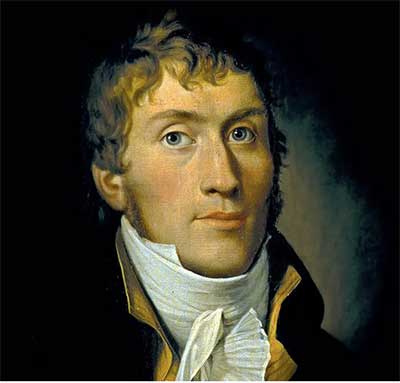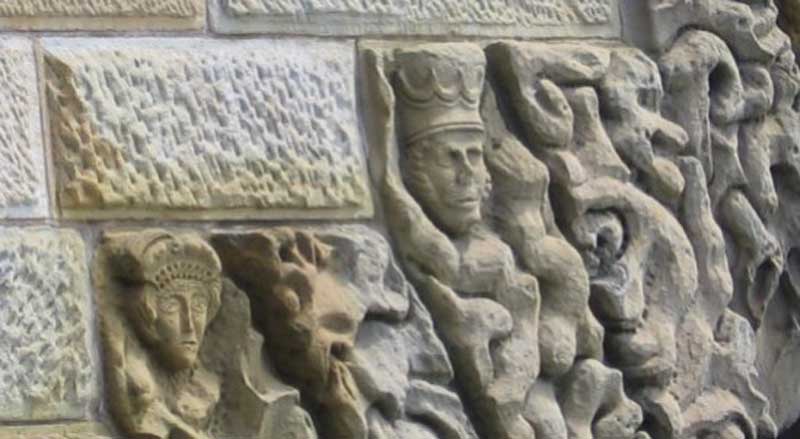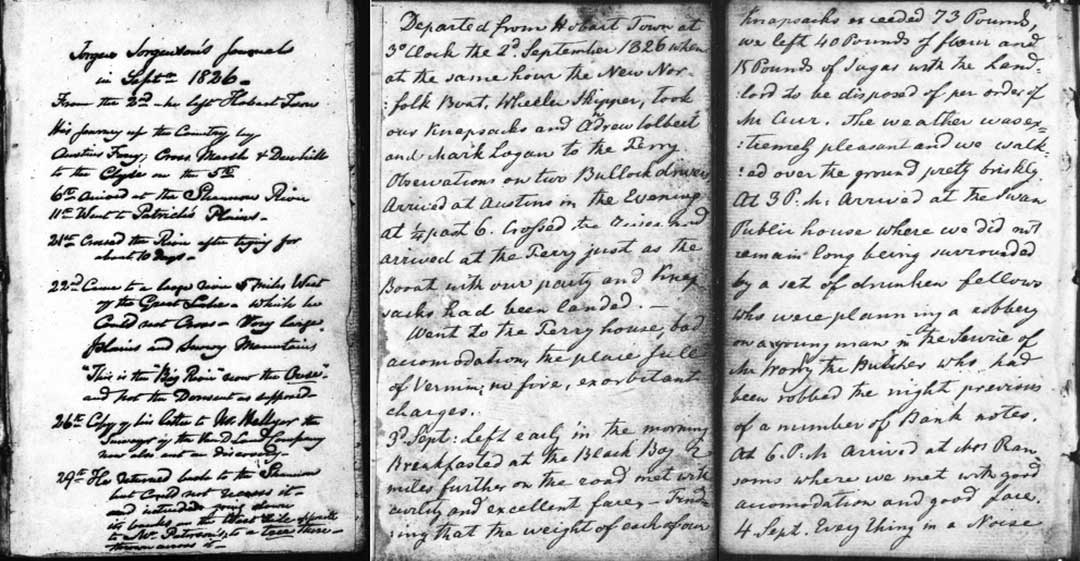Jørgen Jørgensen: The Convict King

Jørgen Jørgensen is one of the most fascinating characters in Tasmanian - indeed Australian - history. Described by historian Marcus Clarke as "a singularly accomplished fortune wooer - one of the most interesting human comets recorded in history", Jørgensen was an associate of the famous botanists Joseph Banks and William Jackson Hooker. He sailed to the colony of New South Wales (Sydney) in 1800 and promptly joined the crew of the survey vessel Lady Nelson. He was present at the establishment of Hobart he explored much of Tasmania including the North West and was employed by the Van Diemen's Land Council as a Constable. He took part in the 'Black Line' Aboriginal clearance exercise and had a hand in the construction of the famous Ross bridge, even managing to have his image engraved on one of the iconic illustrative panels on the bridge.

Jørgen Jørgensen, 'Kimg' of Ross Bridge
Jørgen Jørgensen (name of birth: Jürgensen, and changed to Jorgenson from 1817) (29 March 1780 – 20 January 1841) was a Danish adventurer during the Age of Revolution. During the Action of 2 March 1808 his ship was captured by the British. In 1809 he sailed to Iceland, declared the country independent from Denmark and pronounced himself its ruler. He intended to found a new republic following the United States and the French First Republic. He was also a prolific writer of letters, papers, pamphlets and newspaper articles covering a wide variety of subjects, and for a period was an associate of the famous botanists Joseph Banks and William Jackson Hooker. He left over a hundred written autographs and drawings, most of which are collected in the British Library.
Jørgensen was born as the second son of the royal watchmaker Jurgen Jurgensen. Two of his brothers were watchmakers; the elder, Urban Jurgensen, was of international renown. At the age of 15, Jørgensen finished school and was apprenticed to Captain Henry Marwood of the British collier Janeon. In 1799 he sailed to Cape Town and from there in 1800 to Port Jackson, the new British colony in Australia and to New Zealand. In 1801 he joined the crew of the Lady Nelson. As a member of that crew, Jørgensen was present at the establishment of the first settlements of Risdon Cove and Sullivans Cove in Van Diemen's Land, as Tasmania was then called. He has been called the founder of the city of Hobart Town, now Hobart, and is still a local hero.
He became mate aboard the whaling ship Alexander, and in her returned to Britain, arriving at Gravesend in June 1806.
In 1807, while Jørgensen was visiting his family, he witnessed the Battle of Copenhagen and soon afterwards was given command of a small Danish vessel, Admiral Juul. In 1808 he engaged in a sea battle with HMS Sappho; the British captured Admiral Juul and treated Jørgensen as a privateer. In 1809, while on parole, he suggested to a merchant that a voyage to Iceland could be profitable as the island was suffering from food shortages at the time, due to the Danish monopoly on Icelandic trade. Jørgensen accompanied the voyage of the Clarence as an interpreter. That voyage failed to trade any goods as the ship was British and by that time Denmark and the United Kingdom of Great Britain and Ireland were at war.
Soon after, Jørgensen sailed on a second voyage. On arrival in Iceland the ship's crew found the Danish Governor, Count of Trampe, would still not permit trading. With the help of other crew members, Jørgensen managed to arrest the governor and proclaimed himself 'Protector', promising that he would reinstate the Althing as soon as the Icelandic people were able to govern themselves. His intent was to establish a liberal society in the spirit of those emerging in the Americas and Europe at the time. With the arrival of HMS Talbot two months later, Danish government was restored and Jørgensen was taken back to England and tried by the Transport Board, who found him guilty of breaking his parole while a prisoner-of-war. He was released in 1811.
Jørgensen spent the next few years in London, where he began to drink heavily and gamble compulsively, building up substantial debts which eventually led to his conviction and incarceration. When released from prison in 1812, he travelled to Spain, Portugal and Gibraltar and upon his return to England was again imprisoned when his creditors caught up with him. Following correspondence with the British Foreign Office, Jørgensen was recruited into the intelligence service, where he translated documents and travelled throughout France and Germany as a spy as the Napoleonic Wars drew to a close. In 1815 Jørgensen witnessed the Battle of Waterloo. While he was never involved in the battle, he was situated relatively close to some of the action. Upon returning to England, Jørgensen continued to write various reports, papers and articles but after being accused of theft in 1820, was imprisoned in Newgate Prison, released, and sent back there when he failed to leave Britain (a condition of his parole). A sentence of death was commuted thanks to the actions of a prominent friend and he spent another three years in Newgate before he was transported to Australia in 1825.
After five months at sea, Jørgensen arrived back in Tasmania in 1826. In 1827, after he helped prevent the circulation of forged treasury bills, a group of local merchants headed by Anthony Fenn Kemp petitioned the governor for Jørgensen to be granted a ticket of leave. Jørgensen led several explorations of Tasmania, and was employed by the Van Diemen's Land Council as a Constable, taking part in the 'Black Line' Aboriginal clearance exercise. Jørgensen obtained a free pardon in 1835 but remained in Tasmania. He married an Irish convict, Norah Corbett, in 1831 and died in the Hobart Colonial Hospital on 20 January 1841, age 60.
Jorgensen the Explorer
The exploration of the west and north-west benefited from the establishment in 1825 of the Van Diemen's Land Company. Promised substantial grants, the Company despatched its employees in search of agricultural and pastoral lands. Henry Hellyer and Jorgen Jorgensen were the principal explorers contracted by the Van Diemen's Land Company to search for sheep-grazing lands in the West Country.
Alexander Goldie and Joseph Fossey, in July–September 1826, travelled by boat and overland to Cape Grim, Mount Cameron, Arthur River and, during the return, landed at Detention River. Jorgen Jorgenson, in 1826, attempted to trace a stock route from Hobart across the Central Plateau to Circular Head. Two attempts from the Shannon via Great Lake and Lake Augusta were thwarted by poor weather, with progress restricted to the Walls of Jerusalem, near Lake Adelaide. It was on this expedition that Jorgensen became the first European to lay eyes on the Walls of Jerusalem.
In 1827, Jorgenson and Clement Lorymer made a second attempt, from Circular Head down the west coast to the Pieman River, but the expedition was abandoned and Lorymer drowned in the Duck River during the return. In 1827 Henry Hellyer, the Company's leading surveyor/explorer, reached the Hampshire and Surrey Hills, and climbed St Valentine's Peak (Flinders 'Peak like a volcano') while, the same year, Fossey travelled from Launceston via the Mersey and Forth Rivers and discovered the Middlesex Plains. The Company's grant of 350,000 acres, when finally negotiated, included large sections of Hellyer's and Fossey's discoveries.
Jorgenson spent a lot of time in the bush, between his other employments of writing treatises and working for the police. He saw the harshest side of the wilderness and appears to have been drawn to it: a rushing river swept away one of his colleague Clement Lorymer before his eyes. One night in the Walls of Jerusalem, he watched a log burning in its middle with snow still fixed firmly at each end, so cold it was.

Jorgensen the Writer
In Van Diemen’s Land he was a convicted swindler, a pastoral company employee, an explorer and a police constable. But he was also a talented writer and observer of the colonial situation, becoming interested in Aboriginal Tasmanians after his early expeditions to the north-west of the island. Jorgenson published 'A Shred of Autobiography' in two installments, in 1835 in James Ross’ Hobart Town Almanack (pp. 115-80) and in 1838 in William Gore Elliston’s Hobart Town Almanack and Van Diemen’s Land Annual (pp. 35-155). This autobiography was republished in 1891 in London, under the much more enticing title of The Convict King: Being the Life and Adventures of Jorgen Jorgenson, Monarch of Iceland, Naval Captain, Revolutionist, British Diplomatic Agent, Author, Dramatist, Preacher, Political Prisoner, Gambler, Hospital Dispenser, Continental Traveller, Explorer, Editor, Expatriate Exile, and Colonial Constable. This version was translated into Danish in 1892, as Brudstykker af en selvbiografi, re-edited in 1973 and re-translated into Danish in 2006.
Jorgenson kept journals of his expeditions in Van Diemen’s Land in the late 1820s and also wrote a history of the Van Diemen’s Land Company which included ‘the first record of the way of life of the Aborigines under the stresses of European settlement, by one who had seen them in their natural surroundings and pursuing, to some extent at least, their natural activities’ (Plomley 32). Jorgenson was involved in the beginning of the Black Wars in 1824, with the arrival of Arthur, and with the organisation of the ‘Roving Parties’ for the protection of white settlers and the capture and removal of Aboriginals. He was also a chief organiser of the Black Line in the Oatlands district in 1830.
A book by Jorgenson about the ‘Habits, Manners, and Customs of the Aborigines of Van Diemen’s Land’ was advertised in Hobart in 1837 but never appeared. His study of the ‘Aboriginal Languages of Tasmania’ was published posthumously in the Tasmanian Journal of Natural Science in 1842 (1.4, pp. 308-18). N. J. B. Plomley retrieved the manuscript of Jorgenson’s ‘A Narrative of the Habits, Manners, and Customs of the Aborigines of Van Diemen’s Land’ from the Braim papers in the Mitchell Library, NSW and edited it in a volume entitled Jorgen Jorgenson and the Aborigines of Van Diemen’s Land (1991). This narrative is of comparable importance to George Augustus Robinson’s journals.
The historian James Bonwick knew and used Jorgenson’s treatise. Jorgenson is the subject of a biography by Dan Sprod, The Usurper: Jorgen Jorgenson and his turbulent life in Iceland and Van Diemen's Land 1780-1841 (2001) and has a walk-on part in numerous narratives of convict Tasmania, including recent fiction by Richard Flanagan and Rohan Wilson, and is the subject of a well-reviewed biography by Sarah Bakewell, The English Dane : A Life of Jorgen Jorgenson (2005). The Danish literary historian Svend Erik Larsen reads Jorgenson as a notable trans-hemispherical and bi-lingual instance of a world author, one of that company of European traveller-explorer-writers that includes Ludwig Leichhardt, Stefan von Kotze and Carl Lumholtz (see Larsen).
Related Links
Building Ross Bridge >
